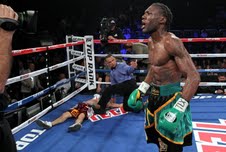The Axe Man goeth
By Bart Barry–

Saturday in Madison Square Garden Theater, the very place Filipino Nonito Donaire’s candidacy for HBO Fighter of the New Century was subverted 3 1/2 years back by a pesky South American, Jamaican featherweight+1 Nicholas “Axe Man” Walters was unable to stretch Colombian featherweight Miguel Marriaga, much to the theater’s icy chagrin. Walters won a unanimous decision, and neither man stopped fighting or so much as clinched for nearly the full 36-minute duration, but it was not enough action, coming in the form of a 127-pound Jamaican and a Colombian featherweight, evidently, to prod New Yorkers to sustained applause.
Here’s how it went Nov. 9, 2013: Corpus Christi, Texas, was balmy and surprisingly humid for the season, American Bank Center was a dump – there was no WiFi, and the crowd lacked spirit – press row was the sort of discombobulated jumble a publicity outfit alone could conjure, and my marriage was in freefall. There were reasons aplenty for distraction, if not outright anxiety, and yet.
One begins as a boxing writer squinting at every fight, interrogating every match for its historical import and metaphorical capacity for yielding capacious metaphors – every four-rounder comprising a tiny chance at an immortality-manifesting phrase like “I saw him when he was fighting nobodies in empty arenas.” The more one sits ringside, the more his attention wanes, and something like guilt replaces the will to examine fighters’ footwork from yesteryear’s fights. Somewhere round one’s 60th fight card, though, a nearly enlightened state happens: I’m going to enjoy the undercard however I wish – watching the scorekeeper in the silly striped shirt, fantasizing about a ringcard girl, chatting with a pal I’ve not seen since last year, texting with my mother, googling the attendance record of the venue; whatever brings joy – and if something sensational happens, it will hit me with concussive force enough I’ll not be able to miss it even if I so wish.
That was Nicholas Walters. On a card that boasted Alex Saucedo, Vic Darchinyan, Mikey Garcia, Nonito Donaire and other less-talented but more-touted participants, the Jamaican featherweight happened with a concussive force too great to miss; in his U.S. debut, against Mexican Alberto Garza, Walters radiated with a violence of intention and act uncommon even among prizefighters. His form was rough, his punches were wild, but for simple force and desire, Walters was unmatchable that night.
I’m biased about Walters, then, and I could not care less if it offends.
He missed weight Friday, and it hurt. Part of the appeal of a Walters, like an Antonio Margarito before him, is the size advantage he brings to confrontations – and that appeal is immediately nullified by unfairness if he does not find a way, whatever way, to touch the contracted weight for at least a moment or two before bounding three or four weight classes upwards in 24 hours. Saturday Walters stood across from a career featherweight in Marriaga, a man who has fought nothing but 126 pounders for six years, and Walters looked enormous.
Walters is too big to be a featherweight, unless he returns to fighting thrice annually, and chews solely ice chips four weeks every year, and that is a real problem because Walters’ technique is a passport-snatching type, one that will not allow his power to travel to other weightclasses, and without the power to terrorize his opponents, Walters has very, very little.
His reflexes are about average, which might not be an issue except for his reliance on them; Walters thinks he is much quicker than he actually is, and a lot of this autoöverestimation comes from amateur experiences enough to anticipate the nature of others’ attacks, his parries triggered by anticipation more than reaction – particularly evident and perilous in round 1 Saturday, when Walters repeatedly sent his right guard out to defend Marriaga’s jab even before the Colombian knew he would throw it.
Walters straightens noticeably when he throws, making the target of his head blink and rise like a cartoon thought bubble with an idea, and despite his physical disadvantages Marriaga saw this and exploited it several times in the opening half of the fight. Walters’ defense is quite poor, too. He regularly employs the shell tactic of lowering his lead hand, and almost as regularly neglects to tuck his chin fully behind his lead shoulder; Walters’ defense is not so much a shell as an invitation.
What makes all this work, though, is the Axe Man righthand Walter wields. It is offense-as-defense in the very best sense: Before an opponent commits to a combination, he asks – and in Marriaga’s case, noticeably asks – “What if this does not knock that guy stiff?” The force of Walters’ overhand right is enough to alter others’ offensive calculations, which very nearly fits a workable definition for great defense.
No featherweight should be hit with Walters’ righthand, not Marriaga, not Vasyl Lomachenko, not God shrunken in a 126-pound form. The consequence of Walters’ righthand removed Marriaga’s desire to throw punches Saturday; yes, Walters’ body blows reduced the force of Marriaga’s punches, but it was the possibility of getting spearchiseled by that righthand that kept Marriaga from even wanting to bother.
No prizefight is gentle, but Saturday’s affair – while conclusively better than the New York crowd opined – was not withering enough to entitle Walters another 2/3-year rest. If he takes a couple weeks off, but not a month, then heads into camp for a Lomachenko match, there’s reason to think he can distill himself to 126 one last time. Walters-Lomachenko is the sort of palate-cleansing affair our beloved sport sorely needs in 2015.
Bart Barry can be reached via Twitter @bartbarry